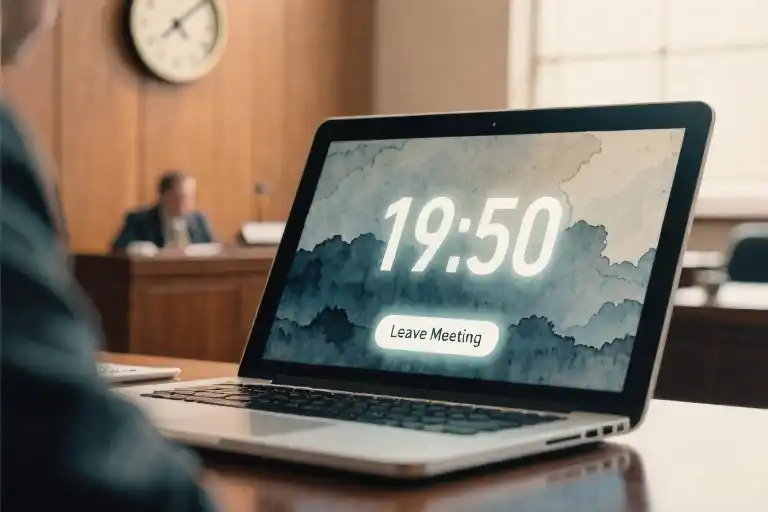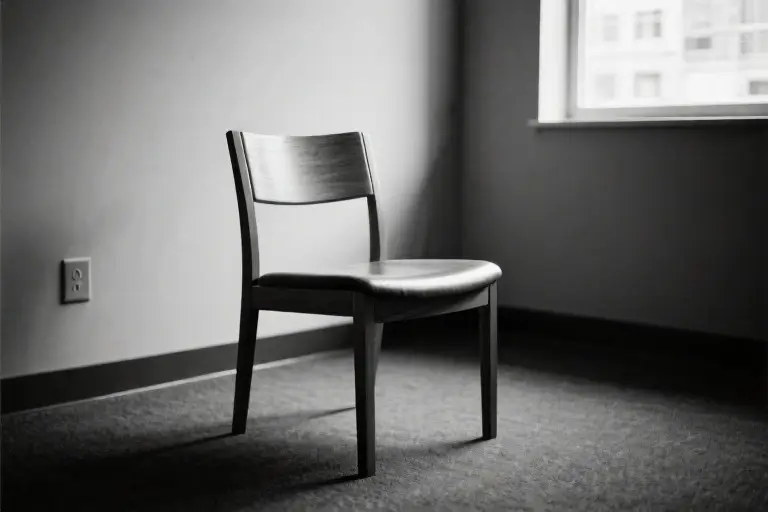The digital clock on the courtroom wall blinked 19:43 in relentless red numerals. In seventeen minutes, the fifteen-year architecture of my marriage would dissolve into a few perfunctory questions and electronic signatures. My ex-husband’s pixelated face floated in a Zoom rectangle beside the magistrate, his office background artificially blurred – our final configuration as legal partners.
Remote divorce proceedings have an antiseptic quality that amplifies their emotional dissonance. The magistrate’s voice crackled through tinny speakers as she administered the oath, her words echoing in the sterile conference room where I sat alone. No children to custody, no property to divide, no lawyers to mediate – just two people and a webcam dismantling what once required solemn congregations of family and clergy.
Three questions formed the entire legal interrogation:
- Do you understand this dissolution is permanent? (19:45)
- Is this decision made without coercion? (19:46)
- Do you believe reconciliation is impossible? (19:47)
Each affirmative reply tightened my throat. The speed of institutional unbinding contrasted sharply with the slow unraveling that brought us here – the accumulated weight of untouched coffee mugs left at each other’s apartments during dating years now reduced to checkboxes on a PDF.
When the magistrate instructed us to sign, my finger hovered over the tablet screen. The signature box shimmered with that peculiar digital fragility, pixels rearranging themselves beneath the stylus like shifting sand. Somewhere three time zones away, my ex was performing the same ritual, our electronic marks materializing simultaneously on documents that would sever our legal tether before either of us could reconsider.
At 19:50, the magistrate pronounced words that carried less ceremony than a restaurant hostess confirming reservations: “Marriage dissolved.” The Zoom window vanished abruptly, leaving me staring at my own reflection in the darkened screen. Fifteen years concluded faster than most lunch breaks, measured by that unflinching digital clock now counting down someone else’s life alteration.
Modern divorce has become a study in cognitive dissonance – the clinical ease of legal dissolution crashing against the tectonic shifts in personal identity. Our streamlined process required less paperwork than refinancing a car loan, yet the emotional audit would take months of inventorying shared memories, disentangling habits, rewriting futures we’d scripted as joint productions.
What the efficient system doesn’t account for are the phantom touches – reaching automatically for a hand that’s no longer contractually obliged to hold yours, or the way muscle memory types an old shared password before remembering it now only grants solitary access. No notary public stamps these intangible losses, though they linger longer than any court decree.
The 20-Minute Legal Alchemy
19:30 Fingerprints on the Mute Button
The Zoom window pixelated as the magistrate adjusted her webcam. My reflection glitched in the corner of the screen—a digital ghost hovering over the “Gallery View” that now framed my soon-to-be-ex and me like museum exhibits. The physical details of remote divorce hearings never make it into legal guides: the way the mute button accumulates fingerprints from nervous toggling, or how courtroom acoustics get replaced by the metallic echo of laptop speakers.
For our no-contest divorce (no children, no asset division beyond our shared Netflix account), the system had reduced marital dissolution to a series of checkboxes:
- ✅ Both parties present (virtually counts)
- ✅ Voluntary agreement confirmed
- ✅ $327.00 court fee paid (charged to our formerly joint credit card)
The digital clock on the magistrate’s wall ticked from 19:30 to 19:31 as she explained the rules. We were participants in a new legal hybrid—part courtroom ritual, part tech support session. When my ex’s audio cut out briefly, I instinctively reached for my phone to text him troubleshooting tips before remembering we’d deleted each other’s contacts last month.
19:35 The Voluntary Confirmation Trio
“Do you both enter into this divorce willingly?” The magistrate’s question hung in the virtual space between our screens. She asked it three separate times with slight variations—legal incantations designed to catch last-minute hesitations. Each iteration felt like peeling off a bandage:
- First pass: Routine formality
- Second round: Reality check
- Final confirmation: Psychological point of no return
Studies show the average couple spends 600 hours discussing divorce before filing. Our three “yeses” took 9 seconds total. The efficiency was almost comical—like canceling a gym membership with more emotional stakes. Through my laptop speakers, I heard my ex exhale during the second confirmation, the same sigh he used to make when finally agreeing to restaurant choices after 15 minutes of “I don’t mind, you pick.”
19:48 The Pixelated Ritual
When the magistrate instructed us to sign electronically, my cursor hovered over the signature box. The digital interface rendered our marital finale in jagged pixels—a far cry from the fountain pen we’d used to sign our marriage license. As I dragged my finger across the trackpad, creating a wobbly approximation of my signature, it struck me that this was our final collaborative act: two people separately drawing on separate devices to formally end what we’d once built together.
The clock hit 19:50 as the magistrate pronounced us divorced. The entire proceeding had taken 18 minutes and 37 seconds—roughly the runtime of a sitcom episode, minus the laugh track. Our marriage certificate had required witnesses, champagne toasts, and a choir singing “All You Need Is Love.” Its dissolution needed only stable Wi-Fi and a PayPal account.
Walking away from my laptop afterward, I noticed the physical artifacts the system leaves behind: an email confirmation with a case number, a PDF of the dissolution decree, and—perhaps most surreal—the “Leave Meeting” button glowing gently on my screen, offering one final piece of procedural poetry.
The Unraveling: When 15 Years of Evidence Collapses
The Anatomy of Touch Aversion
It began with the small things – the way my hand would instinctively flinch when his fingers brushed against mine while passing the salt. Where once there had been comfort in casual contact, now even accidental grazes sent warning signals through my nervous system. Our bed became a demilitarized zone, with pillows strategically placed to maintain territorial boundaries.
This touch aversion didn’t arrive overnight. Like rust on iron, it formed gradually through countless micro-moments of emotional neglect. The last time we held hands properly was at a friend’s wedding two years prior – an unconscious pantomime of intimacy that left my palm sweaty with the effort of pretense. By the end, even the thought of his arm around my shoulders made my trapezius muscles contract defensively.
Digital Gravestones: Social Media’s Cruel Calendar
Facebook’s memory feature became a particularly savage historian. Every anniversary, the platform dutifully surfaced photos of our beaming faces from happier years, creating a side-by-side timeline of hope versus reality. The algorithmic cheerleading – “Congratulate the happy couple on 12 years together!” – felt like being waterboarded with nostalgia.
I’d scroll through these digital artifacts with forensic detachment. That sunset photo from Santorini in 2015? Taken minutes after a silent breakfast fight. The grinning pumpkin-carving shot from 2018? Captured during the year we stopped having sex altogether. The platform’s machine learning, trained to recognize smiles but not sorrow, kept serving up these landmines wrapped in celebratory stickers.
The Unopened Lifeline
On my bookshelf, still in its shrink wrap, sat The Seven Principles for Making Marriage Work by John Gottman. Purchased during our final Christmas together, it represented the last gasp of our repair attempts – a Hail Mary pass that never left the quarterback’s hands. The unbroken seal became a running joke between us, then a sore point, then finally a museum piece in the gallery of our failures.
Other relics accumulated like sediment: unused couples therapy vouchers expired in my wallet, a shared journal with only three entries, the YouTube playlist of “relationship repair” TED Talks we promised to watch together. These untouched remedies formed their own peculiar evidence – not of malice or dramatic betrayal, but of something perhaps more fatal: the quiet, mutual surrender to emotional entropy.
The Paper Trail of Love
Sorting through our documents for the divorce proceedings, I uncovered the archaeological layers of our union. The mortgage applications and joint tax returns created a peculiar parallel narrative to our romantic history. Here was the paper trail of practical commitment, outlasting the emotional connection that birthed it.
Most jarring was seeing our signatures side by side on various forms – the way my looping J had once nestled against his angular K like puzzle pieces. Over the years, our handwriting maintained its distinct personalities even as our marital identities blurred and eventually dissolved. The divorce papers would be the last legal document to bear this juxtaposition – a final, bureaucratic kiss goodbye.
The Ghosts of Future Plans
In my desk drawer, I found a folder labeled “Future Projects” containing brochures for retirement communities, printouts about adopting older children, and a spreadsheet comparing RV models for the cross-country trip we’d planned for our 20th anniversary. These yellowing documents represented the ultimate casualty – not just the loss of what we had been, but the obliteration of what we might have become.
The particular grief of uncontested divorce contains this unique flavor: mourning hypothetical futures rather than fighting over tangible pasts. With no dramatic infidelity or explosive fights to point to, we were left grieving the death of potential itself – all those unlived versions of ourselves that had seemed so real in the planning stages.
The Paradox of Clean Breaks
There’s a cruel irony in how easily the legal system untangles lives that have become psychologically inseparable. The magistrate’s rubber stamp had more power to declare us “single” than fifteen years of gradual estrangement. I found myself envying couples who divorced amid screaming matches and broken china – at least their external drama matched their internal experience.
Our civilized dissolution felt like being put under anesthesia for an amputation. The procedure itself was painless, but the phantom limb sensations would linger for years. When people praised our “mature” approach to divorce, I wanted to scream that maturity had nothing to do with it – we were simply two people who’d run out of emotional currency to spend on each other.
The Museum of Us
In the weeks following the divorce, I began curating what I came to think of as The Museum of Us – a mental archive where I could preserve our history without letting it dominate my present. Some artifacts deserved preservation: the mix CD he made me during our first summer together, the hiking boots that carried us through countless trails, the inside jokes that still made me smile despite everything.
Other items required ceremonial disposal. I burned our marriage certificate in a backyard ritual that felt more cathartic than any courtroom procedure. The ashes mixed with soil where I later planted a Japanese maple – something that could grow from what remained.
This, perhaps, is the true work of uncontested divorce: not the legal severance, but the careful archaeology of a shared life. It’s slow, meticulous labor – separating the artifacts worth keeping from those that need burying, learning to visit the past without living in it. The digital clock in the magistrate’s office may have counted down our final minutes as a married couple, but this curation project operates on an entirely different timeline – one measured in seasons rather than seconds.
When Love Becomes a Terminable Contract
The digital clock on the courtroom wall had just blinked from 19:49 to 19:50 when the magistrate pronounced those two words: “Marriage dissolved.” In that sterile moment, our fifteen-year relationship transformed into what modern bureaucracy understands best—a successfully terminated contract. The irony wasn’t lost on me that this transaction took less time than canceling a Netflix subscription.
The Subscription Model of Modern Marriage
We’ve entered an era where commitment mirrors our digital consumption patterns. Like software licenses that auto-renew until we manually opt out, contemporary marriages continue by default until someone files Form FL-100. The parallels are unsettling:
- Trial periods: The average couple dates for 3.5 years before marrying (Pew Research 2022), not unlike free app demos
- Service tiers: From prenups to postnups, we customize our marital “plans”
- Cancellation policies: No-fault divorce laws in all 50 states function like no-questions-asked refund policies
My Zoom divorce hearing laid bare this transactional reality. As we recited scripted responses to the magistrate’s questions, I remembered our wedding vows—equally scripted, equally binding, yet somehow more emotionally taxing to undo than to establish.
The Middle-Class Anxiety Behind Amicable Splits
What sociologists call “the quiet revolution” in marital dissolution reveals itself most clearly among educated urbanites. Our divorce required:
- Zero courtroom drama
- A shared Google Drive folder for document exchange
- More emotional labor spent dividing vinyl records than financial assets
This civilized approach masks deeper anxieties. When splitting becomes this frictionless, it forces uncomfortable questions:
- Did we give up too easily?
- Is commitment becoming obsolete in our swipe-right culture?
- Why does dissolving a business partnership require more paperwork than ending a marriage?
The answers may lie in our changing relationship with permanence. Millennials average 4.2 jobs in their first decade post-college (BLS data)—we’re accustomed to course-correcting our lives. Yet this adaptability clashes with lingering romantic ideals of “till death do us part.”
Two Timelines of Healing
My physical proof of marriage’s end came in two forms:
- The pale band on my left ring finger where sunlight hadn’t touched skin in twelve years
- The notarized dissolution document in my desk drawer, still crisp at the edges
These markers heal at different rates. The tan line faded within weeks, but the legal document’s emotional weight lingers like a phantom limb. Perhaps this discrepancy explains why no-fault divorce, while administratively simple, still leaves psychological complexity in its wake.
Modern love exists in this paradox—we’ve streamlined the mechanics of separation while doing little to ease its existential toll. As I left the virtual courtroom that evening, one thought persisted: We’ve mastered the art of clean breaks, but are we any better at knowing when to hold on?
The Dual Liberation on Courthouse Steps
Stepping out of the virtual courtroom felt like exiting two marriages simultaneously – the legal union that just dissolved in 20 minutes, and the emotional partnership that had been unraveling for years. The late afternoon sun hit my face with the same indifferent brightness as it had on our wedding day.
When Paperwork Ends But Processing Begins
The magistrate’s final “case closed” notification carried an eerie similarity to email confirmations for canceled subscriptions. Yet unlike terminating a streaming service, this digital closure came with physical aftershocks – my left hand kept absently rotating the no-longer-there wedding band, fingers tracing the pale indentation like a phantom limb.
This is the paradox of uncontested divorce: the cleaner the legal resolution, the messier the emotional aftermath. Without battles over assets or custody to channel our energy, all that remained was the quiet shock of how effortlessly the state could undo what took us years to build.
The Myth of the Clean Break
Modern divorce culture celebrates “clean breaks” as the ideal – no drama, no conflict, just two reasonable adults moving on. But beneath this civilized facade lingers unspoken grief. When I shared news of our amicable split, friends praised our maturity with comments like “At least you’re doing it the right way.” Their relief revealed society’s discomfort with marital failure – we’d rather romanticize dignified exits than acknowledge the universal ache of detachment.
The truth no uncontested divorce guide mentions: signing those papers feels like performing surgery on your shared history with office scissors. The legal system gives you forms for dividing property, but no paperwork exists for splitting:
- The muscle memory of their coffee order
- Friends who’ll inevitably choose sides
- The mental calendar still marking in-laws’ birthdays
Two Timelines of Healing
As I stood on the courthouse steps (technically my home office doorway), two distinct clocks started ticking:
- The Administrative Timeline
- Day 1: Update marital status on insurance
- Week 2: Notify banks and credit agencies
- Month 3: File single-status tax returns
- The Emotional Timeline
- Day 1: Cry during a detergent commercial featuring happy couples
- Week 2: Accidentally set dinner plates for two
- Month 3: Finally delete the shared grocery app
Legal systems measure divorce in filing dates and waiting periods, but heartbreak operates on its own calendar. That pale band of skin where my ring once sat will likely fade before I stop reaching for it absentmindedly.
The Questions That Remain
Perhaps the greatest irony of our streamlined divorce was realizing how much quicker bureaucracy moves than the human heart. The magistrate asked three times if we were certain – a 90-second interrogation about a 15-year relationship. We answered mechanically, having done our real questioning in the lonely months before filing.
What the forms don’t capture:
- Was there a precise moment when “for better or worse” became “just worse”?
- How many unvoiced disappointments equal one dealbreaker?
- When did our private jokes stop being funny?
These aren’t legal questions but human ones, the kind that surface at 2 AM when the divorce decree sits filed but the memories won’t stay archived.
Moving Forward With Gentle Honesty
If I could amend those standard divorce documents, I’d add a final page acknowledging:
“By signing below, you agree that healing isn’t linear. Some days you’ll feel liberated, others you’ll inexplicably miss their terrible driving directions. This is normal. The state declares your marriage over today, but your heart may need seasons to concur.”
For those considering uncontested divorce, know this: the simplicity you crave in the legal process may highlight the complexity you’ll face afterward. And that’s okay. There’s courage in clean endings, but equal bravery in admitting that some mornings, you’ll still wake up reaching across an empty bed.
The digital clock in that hearing room stopped counting minutes for our case, but my personal timer for recovery just started. Both matter – just in different ways.





